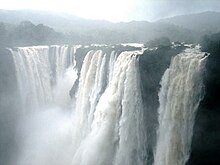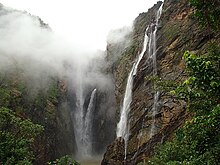Jog Falls
| Template:Wikify is deprecated. Please use a more specific cleanup template as listed in the documentation. |
This article contains content that is written like an advertisement. (August 2011) |
This article needs additional citations for verification. (August 2011) |
| Jog Falls | |
|---|---|
 Jog Falls during monsoon | |
 | |
| Location | Sagara, Karnataka, Shimoga District, Karnataka, India |
| Coordinates | 14°13′44.36″N 74°48′43.99″E / 14.2289889°N 74.8122194°E |
| Type | Cataract, Segmented |
| Elevation | 1600ftMSL(488metres) |
| Total height | 829 feet/253 meters |
| Number of drops | 1 |
| Longest drop | 829 feet/253 meters |
| Average width | 1550 feet/472 meters |
| Watercourse | Sharavathi River |
| Average flow rate | 5,387 cu ft/s or 153 m³/s |

Jog Falls (Kannada: ಜೋಗ ಜಲಪಾತ), created by the Sharavathi River falling from a height of 253 m (830 ft) is the second-highest (after the Nohkalikai Falls with a height of 1100 feet (335 metres) in Meghalaya) plunge waterfall in India[1] Located in Sagara, Karnataka Shimoga District of Karnataka state, these segmented falls are a major tourist attraction. It is also called by alternative names of Gerusoppe falls, Gersoppa Falls and Jogada Gundi.[2]
There are many waterfalls in Asia - and also in India - which drop from a higher altitude. But, unlike most of such falls, Jog Falls is untiered, i.e., it drops directly and does not stream on to rocks. Thus, it can be described as the second-highest untiered waterfall in India. The waterfall database gives it 83 scenic points while Angel Falls is at 97.
Description
Sharavati, a river which rises at Ambutirtha, near Nonabar, in the Tirthahalli taluk and takes the north-westerly course by Fatte petta, receives the Haridravati on the right below Pattaguppe and the Yenne Hole on the left above Barangi. On arriving at the frontier it bends to the west, and precipitating itself down the celebrated Falls of Gersoppa and passing that village (properly Geru-Sappe), which is really some 29 Kilometres distant, discharges into the sea at Honnavar in North Kanara. The name Sharavati, arrow-born, is in allusion to its flowing from the Ambutirtha, which was formed by a stroke of Rama's arrow. The stream is crossed by 70 anicuts, from which small channels are drawn having an aggregate length of 42 Kilometres.
The magnificent Falls of Gersoppa or Jog, that is, the waterfall, are unquestionably the grandest natural beauty in Karnataka, rich as it is in splendid scenery. They eclipse every other Fall in India and have few rivals in any part of the world. "While excelled in height by the Cerosoli and Evanson cascades in the Alps, and the Falls of the Arve in Savoy, the Gersoppa cataract surpasses them in volume of water precipitated ; and while much inferior to Niagara in volume, it far excels those celebrated falls of the New World in height. L.Bowring says:- "It may truly be called one of the wonders of the world, for though the volume of water is less than that of the Cauvery, the immense height of the chief fall is almost without a parallel."

Their existence appears to have been unknown at the time of Buchanan's journey in 1900. The Sharavati, flowing over a very rocky bed about 250 yards wide, here reaches a tremendous chasm, 960 ft (290 m) in depth, and "performs (as Captain Newbold has expressed it) this stupendous lover's leap from the chains of the giant Ghats into the arms of his ocean-rescued mistress- prolific Kanara." This is in allusion to the legend of the formation of the western coast by Parasu Rama.
The water comes down in four distinct falls, presenting a scene of transcendent grandeur and sublimity, whose effect is greatly heightened by the wild and beautiful country around, covered with a wealth of luxuriant vegetation. The Raja Fall pours in one unbroken column sheer to the depth of 830 ft (250 m). Half way down it is encountered by the Roarer, another fall, which precipitates itself into a vast cup and then rushes violently downwards at an angle of forty-five degrees to meet its famous compeer. A third fall, the Rocket shoots downwards in a series of jets; while the fourth, called the Rani (Dame Blanche), is an Undine-like cascade gliding quietly over the mountain side in a sheet of foam.
The most favorable time for visiting these glorious works of nature is in the Monsoon season, though it is enveloped in a dense cloud of vapour, through which rises the thunder of the invisible mighty waters in their fearful descent.There are good bungalows on both sides of the falls. Close by the side of Bombay Bungalow is a slab of rock projecting over the verge of the gulf, by lying down on which and peering over, the best view is obtained of the appalling abyss from above, rendered more striking by the continual flight across it of myriads of rock pigeons, which find a congenial home in the face of the cliffs.
Says a visitor in the month of August about 130 years ago " I lay down flat on this shelf and drew myself up to its edge, over which I stretched my head. A sight burst on the view which I shall never forget and can never hope to describe. I have since looked down the fuming and sulphurous craters of Etna and Vesuvius, but have never experienced the sensations which overwhelmed me in the first downward gaze into this (hibernice) volcano of waters; for so it looks ; a chaotic scene that rivets with basilisk fascination the gaze of the spectator. It was with great reluctance and with an intense feeling of depression that I withdrew my head, drenched in spray, from the brink of the precipice. One might almost gaze for ever on this abyss in which a mighty mass of water appears eternally burying itself in a mist-shrouded grave. The clouds of spray which continually ascend heavenwards in slow and majestic wreaths appear to typify the shadowy ghosts of the entombed waters."
The Falls are seen to greatest advantage from the selected points of view which have been cleared on the Mysore bank, the most popular being Watkin's platform. From this side a descent may be made to the pool below, the water in which is 130 ft (40 m) in depth.But this is a difficult undertaking and the re-ascent extremely laborious. The view looking upwards from below is generally considered far less impressive than from the other points, as regards the Falls themselves, but the grandly rugged features of the chasm and the winding gorge in which it is prolonged are more clearly seen in all their savage nakedness.
The varying effects of light and shade at different hours are extremely beautiful. A lovely rainbow spans the waters in the afternoon, rising with the declining sun, and even lunar rainbows are said to be formed in certain aspects of the moon. Rockets and blazing torches or bundles of straw, cast over on a dark night, throw out a fitful glare upon the jaws of the abyss, producing weird and solemn effects as viewed from the Raja's Rock. No words can suffice to adequately describe the charms of a scene replete with every element of the sublime, combining in one superb panorama so many varying aspects both of terror and of beauty, all instinct with the life, the force and play of moving waters.
River Sharavathi splits up into four different tracks which are named in accordance with their perceived trajectories.[3] Going from left to right respectively in the picture, the names and the reasons for naming are:
- Raja (King): Named so because of its apparently 'dignified' and 'serene' fall.
- Roarer: This stream appears out of a mass of rocks, making a tremendous amount of noise.
- Rocket: Consists of a large volume of water streaming out of a small opening at a very high speed.
- Rani (Queen), also called Lady Dame Blanche: The stream has a winding, twisting trajectory, said to resemble the movements of a female dancer.
Watch Video of Jog Falls here (offseason) http://www.weedioh.com/Video.aspx?VideoId=2495
Significance
Associated with the waterfall is the nearby Linganmakki Dam across river Sharavathi,.[4] The power station has been operational since 1948, and is of 120 MW capacity, one of the largest hydro-electric stations in India at that time and a small source of electric power for Karnataka now. The power station was previously named Krishna Rajendra hydro-electric project, after the King of Mysore at that time. The name was later changed to Mahatma Gandhi hydro-electric Project. It was served by Hirebhaskara dam until 1960. After 1960, thanks to visions of Sir M. Visvesvarayya, Linganmakki Dam, built across river Sharavathi is being used for power generation.This new dam serves LDPH (55 MW), SGS(1035 MW) and Gerusoppa Tail race(240 MW)generating stations and the old Hirebhaskara dam got submerged in 'as was' condition.
Change in flow
Before the onset of the monsoon, when there is not much water in the Linganmakki dam, the Jog Falls are nearly unrecognizable. Instead of the roar and the spray and the massive flow of water, there are only a pair of thin streams of water trickling down the cliff as the water collected in the dam is exclusively for generation of electricity and during monsoons local rain-water is the source of water to the falls. If you happen to ask any of the local people what happened to the falls, they would tell you that the monsoon rain amount has changed, which is true. During the monsoon of 2007, due to heavy rains, the authorities at the falls had to open the dam. Due to this, the water falls was seen at its best. Unfortunately this also resulted in the flooding of many villages down the river, destroying crops and the fishing industry for weeks. Many of the pictures in the gallery and the picture displayed alongside show the falls during that time.
Gallery
-
Jog Falls in early monsoon
-
Jog Falls in late monsoon
-
Jog Falls from bottom
-
Jog Falls from below
-
Jogfalls after good monsoon
-
Jogfalls sectional view
-
Canal Gates near Jogfalls
-
Jog Roarer
-
Jog Raja
See also
References
C.Hayavadana Rao, B.A.,B.L., Fellow, University of Mysore, Editor, Mysore Gazetteer, 1930 Edition, Government Press, Bangalore.









